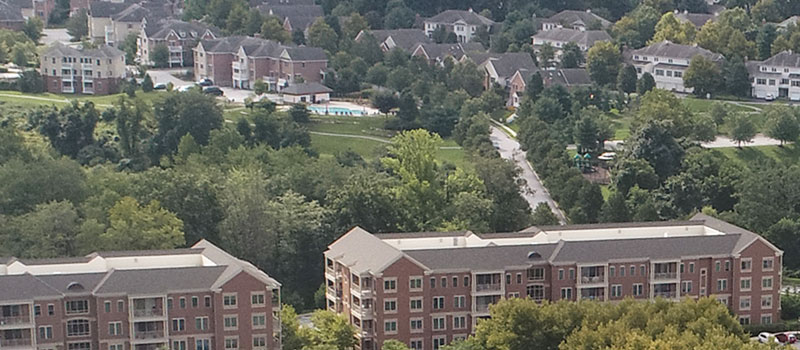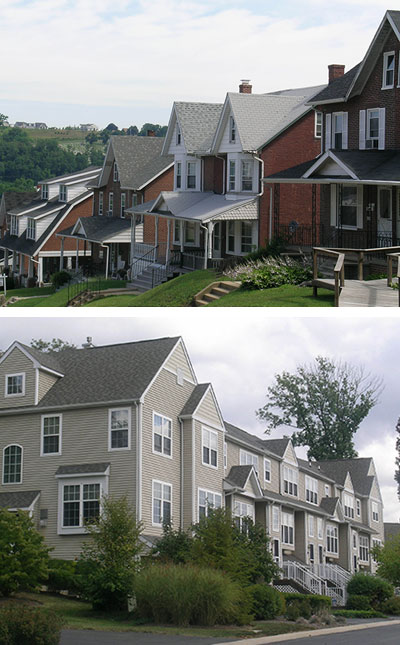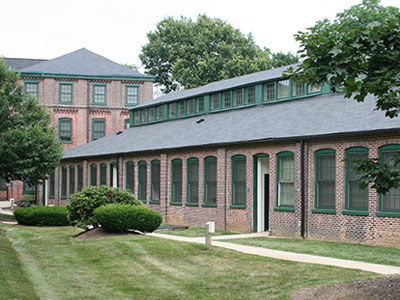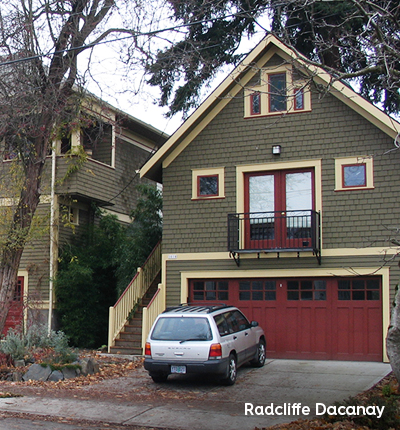Traditional twins and modern townhomes are examples of housing diversity.
How it Works
Housing in Chester County has traditionally been comprised primarily of single family detached homes. Townhomes, duplexes, and apartments are also common housing types in the County. Recent shifts in demographics have highlighted the need for housing diversity. Single person households in Chester County are expected to increase from 42,000 people in 2015 to 67,000 in 2045, generating an anticipated increase in demand for smaller, lower cost housing. In the same time period, the senior population is expected to grow from 65,000 to 129,000 people, necessitating additional housing diversity to accommodate aging-in-community. Housing diversity can be addressed through new development and rehabilitation of existing housing.
The Pennsylvania Municipalities Planning Code (MPC) requires that municipalities address housing diversity through their comprehensive plans and zoning ordinances. Specifically, Section 301.(a)(2.1) of the MPC requires that municipal or multi-municipal comprehensive plans include a housing plan to meet the housing needs of present residents and of those individuals and families anticipated to reside in the community. The plan must consider the accommodation of expected new housing in different dwelling types and at appropriate densities for households of all income levels. Section 604.(4) of the MPC requires municipal zoning ordinances to provide for residential housing of various dwelling types encompassing all basic forms of housing including single-family and two-family dwellings, and a reasonable range of multifamily dwellings, mobile homes and mobile home parks.
Municipalities can plan for housing diversity by addressing the need in their planning policies, zoning ordinances, subdivision and land development ordinances, and by public and developer outreach. Housing diversity can be accomplished through new development and through rehabilitation of existing housing.
Housing can range widely in density and ownership structure and can come in many different forms including:
- Single-family detached
- Accessory dwelling units (attached and detached)
- Carriage homes
- Live-work units
- Mobile homes
- Mini-homes
- Manufactured housing
- Twins and duplexes
- Triplexes
- Quadraplexes
- Townhouses/Rowhouses
- Stacked townhouses
- Multifamily apartments
- Micro apartments
- Residential conversions
- Co-living housing
- Residential and non-residential mixed-use
- Transit Oriented Development (TOD)
- Farmworker housing
- Age-restricted housing
Adaptive reuse of historic properties can provide opportunities for housing diversity.
Benefits
Affordably-Priced Homes
Housing diversity can increase the range of housing prices.
Economic Stability
Housing diversity helps employers attract and retain staff.
Aging Population Support
Housing that addresses the spectrum of senior income levels and lifestyle choices or limitations allows seniors to remain in and contribute to their local communities.
Fair Share Obligations
Accommodating a wide range of housing types allows a municipality to address their fair share obligations for multi-family housing.
Fiscal Benefits
Housing diversity provides tax revenue through property tax, and sales tax generated from resident spending. Small dwelling units generate fewer school age children, which generates lower tax burdens than detached single-family homes.
Efficient Use of Infrastructure
Diverse housing such as infill development, accessory dwelling units, and adaptive reuse utilizes existing infrastructure.
Open Space Protection
Housing diversity can support open space preservation by allowing compact growth and reducing land consumption.
An accessory dwelling unit constructed over a detached garage can add more housing options while being seamlessly incorporated into neighborhoods.
Get Started
A municipality should begin by reviewing the housing policies in their comprehensive plan to ensure that they are meeting the minimum requirements for a housing plan as described in Section 301.(a)(2.1) of the Pennsylvania Municipalities Planning Code (MPC). Following these guidelines will also help to ensure that the "fair share" of housing types under the MPC and associated case law is being met (see below for more "fair share" information). The housing plan component should also consider Section 604.(4) of the MPC which applies to zoning and requires municipalities to allow for a wide range of housing types. Through their planning process, municipalities should identify where the most appropriate areas will be for housing of different types and densities based on their growth and preservation goals. Areas such as greyfields and office parks should also be considered as potential housing sites.
Municipalities should next review their zoning ordinances and regulatory documents to implement the housing policies identified in their comprehensive plan and in compliance with the applicable articles of the MPC. When reviewing these documents, the potential impact of the regulations on accommodating diverse housing should be analyzed. Regulations on lot sizes, parking requirements, setbacks, height restrictions, and density restrictions can all affect the built form of housing. Allowing for a wider variety of newer types housing beyond the standard single-family detached, twins, townhouses, and apartments should be considered.
Comprehensive plan updates and amendments to municipal ordinance provisions that are needed to accommodate diverse housing development are eligible for funding from Chester County's Vision Partnership Program.
Considerations
Neighborhood compatibility
Standards should be developed to best integrate the variety of housing forms into the existing built environment. The use of form based codes is one method to ensure new compact development is consistent with existing neighborhood character.
Community Opposition
Increases in density and changes in housing types may cause pushback from adjacent residents. Municipalities could consider encouraging housing development appropriate to the neighborhood through zoning ordinances, developer outreach, and working with community members to determine how to best provide for a range of housing options for residents.
Regulatory Barriers
Municipal regulations may contain standards that favor large-lot, single-family detached housing. Permitted residential densities, parking requirements, setbacks, and minimum lot sizes may need to be adjusted.
Market Demand
Developers may need to be encouraged to develop alternative housing forms to address changing demographics. Municipal regulations may need to be revised to accommodate those changes and resulting market demands.
Municipal Fair Share Obligations
The Pennsylvania Municipalities Planning Code (MPC) lists as one of the required purposes of zoning the need to provide for various types of dwelling units, including single family, two family, and a reasonable range of multiple family housing (Section 604.4). Pennsylvania case law also has required that each municipality provide for all basic forms of housing and meet the housing needs of both present and future residents. The analysis of the municipality's responsibility in this regard is termed the "fair share" analysis, and consists of three tiers:
- Is the municipality a logical area for growth and development? (i.e., Is it in the path of growth?)
- Is the municipality a developed or developing community?
- Is the amount of land available for multi-family development disproportionately small, in relation to population growth pressure and present level of development?
When updating zoning ordinances, a municipality should have a qualified planning consultant or their solicitor review the ordinance for consistency with fair share requirements and case law.
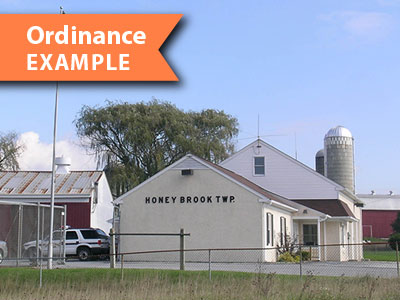
Honey Brook Township
The Traditional Neighborhood Development Overlay District in Part 24 of the Zoning Ordinance encourages incentives for a mix of residential and other types of development in Rocklyn Station.
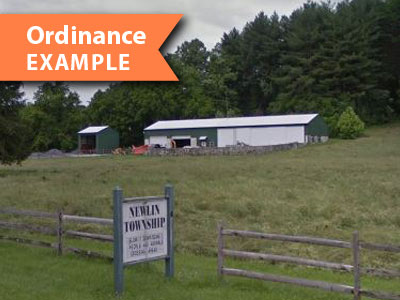
Newlin Township
Section 309.C. Discretionary Density Bonuses of the Newlin Township Zoning Ordinance includes a provision for encouraging "least-cost" housing. A density increase is permitted where the applicant provides on-site or off-site housing opportunities for low- or moderate-income families.

West Vincent Township
The West Vincent Township Sustainability Plan includes policies that promote a variety of moderately housing opportunities and a more diverse population.
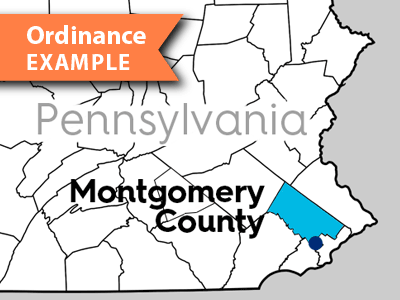
Narberth, PA
Narberth, PA has enacted a Form Based Zoning Code, which enabled the municipality to encourage varying densities of development while maintaining community character.
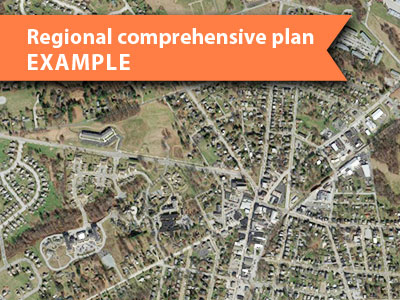
Oxford Region Multimunicipal Comprehensive Plan
This regional plan which includes Oxford Borough and East Nottingham, Elk, Lower Oxford, Upper Oxford and West Nottingham Townships, recognizes the need for workforce housing for the occupations needed in each municipality. The Housing Plan Component recommends that the municipalities coordinate with agricultural employers and non-profit housing providers to assist low-income workers to access housing that meets building quality and occupancy standards.


